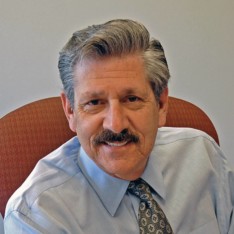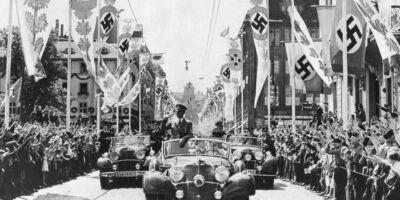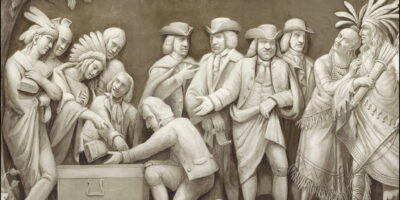Austrian Economics on the 45th Anniversary of Its Rebirth
This June marks the 45th anniversary of the revival of the Austrian School of Economics. During the week of June 15-22, 1974, the Institute for Humane Studies brought together about 50 people in South Royalton, Vermont to listen to a series of lectures by three of the leading figures of the, then, existing remnant of the Austrian School. The conference served as a catalyst for the rebirth of Austrian Economics over the following decades.
To begin with, Austrian Economics really has nothing to do with the economics of the Republic of Austria. Its name comes from the fact that several of the founding members of this approach to understanding man, society, and the economy lived in the old Habsburg Empire of Austria-Hungary in the last decades of the 19th century. Their immediate students also lived in the Austria of the early decades of the 20th century, and they, in turn, educated another generation of “Austrian” economists before the catastrophe of the 1930s and 1940s with the rise of fascism and Nazism in Europe, which resulted in the dispersion of many of the School’s members to other lands, especially to the United States.
The uniqueness of the Austrian School, it may be said, is that it refused to be hypnotized by the lure of hyper-mathematization and empiricist quantification of all things economics, in the process of which, the Austrians have often argued, some of the uniquely human and humane aspects of the study of man were “lost in translation” when reduced mostly to the measurable and the purely mathematical.
The other element central to the Austrian approach has been a focus on the market economy as a competitive process of dynamic adaptation and adjustment to change, the cumulative results of which, when markets are free and open, are in the direction of improved standards of living, greater choices and opportunities, and widened potentials for human harmonies in place of conflict and war.
Carl Menger, Founder of the Austrian School
It all began in 1871, with the publication of a book by Carl Menger (1840-1921) that when translated into English appeared with the rather simple title of Principles of Economics. In its pages was presented a clear, logical and cogent explanation of the nature of human choice and decision-making under conditions of inescapable scarcity; and how people weigh alternatives at “the margin” in the form of trade-offs of choosing preferred combinations of desired goods and services.
However, a distinct property of Menger’s exposition of this logic of the human mind was that he linked it to the reality of inherent uncertainty concerning the possibilities and outcomes of the future; the pervasiveness of the passing and use of time in all human production and consumption activities; and the need to form expectations concerning the possible shape of things to come in selecting ends and designing the use of means for trying to attain them.
Also, different from other parallel emerging schools of economics at the time that were also explaining and introducing the central idea of marginal decision-making was that Menger’s emphasis was far less on a hypothetical and transitory “equilibrium” between various market supplies and demands. Menger’s attention was centered on the nature and workings of the never-ending processes of social and market interactions that are tending the patterns of human associations in the direction of interpersonal coordination, even if some perfectly balanced end-states are never reached.
Also, more pronounced in Carl Menger’s analysis of the social world was his attention to the origins and evolutionary processes out of which emerged many of the essential institutions of human society: language, customs and traditions, the structure and content of law, the procedures for market association and interaction, and use and development of media of exchange (money). While most other approaches to economics took the institutional order as “given” and taken for granted, starting with Carl Menger, the sociology and economics of human institutions was integral to much of the “Austrian” approach to analyzing the market process. (See my article, “Carl Menger and the Foundations of Austrian Economics”.)
Menger’s Students: Böhm-Bawerk and Wieser
Menger inspired two young followers who took his writings and ended up making then internationally renowned as the economics of the Austrian School. These were Eugen von Böhm-Bawerk (1851-1914) and Friedrich von Wieser (1851-1926), who discovered Menger’s Principles of Economics while fellow students doing their graduate studies and, besides, ended up as brothers-in-law, when Böhm-Bawerk married Wieser’s sister.
Wieser developed Menger’s theory of subjective (or personal) value for explaining the logic of marginal choice, and extended it to the theory of costs. The earlier classical economists (such as Adam Smith and David Ricardo) claimed that the “cost” of goods was determined by the quantity of labor effort that had gone into their manufacture. Wieser showed that the “cost” of anything was ultimately the subjective value to an individual of the alternative end that must be given up in applying some of the available scarce means to try to attain a goal considered of greater personal value that the alternative foregone. Costs as well as benefits are evaluative estimates in the mind of the choice-making actor.
Böhm-Bawerk’s contribution was to extend Menger’s analysis of the role of time in the economic process to a more fully developed theory of capital formation, investment, a notion of the “period of production,” and of interest rates as derived from the time preferences of savers and investors trading the use of resources between the present and the future. In the middle of Böhm-Bawerk’s exposition of capital and interest, he formalized far more than Menger the logic of marginal decision-making and the process of price formation out of the rivalrous bids and offers of suppliers and demanders in the marketplace. Furthermore, building on Menger’s approach, Böhm-Bawerk formulated one of the most devastating refutations of Karl Marx’s theory of capitalist exploitation of workers. (See my articles, “Eugen von Böhm-Bawerk: Sesquicentennial Appreciation” and “The Austrian Economists Who Refuted Marx and Obama”.)
Ludwig von Mises on Money, the Business Cycle, and Socialism
But whatever the essential achievements of these founding contributors to the Austrian School, the generation between the two World Wars was equally original and insightful in the ways they developed, refined, and extended these ideas in new directions. The most profound of these interwar contributors was, without a doubt, Ludwig von Mises (1881-1973). More than other members of the Austrian School at this time, Mises ended up formulating a thorough and logically consistent system of ideas traceable from Carl Menger’s “individualist” and “subjectivist” approach.
Before the First World War, Mises had developed what became known as the Austrian theory of money and the business cycle. He synthesized Menger’s theory of money and Böhm-Bawerk’s conceptions of capital and interest with the monetary economics of the Swedish economist, Knut Wicksell. In this distinct framework, Mises demonstrated both the dynamics of how changes in the money supply may have non-neutral distorting effects on the structure of relative prices, the allocation of resources among competing uses in the economy, and they may redistribute income among individuals and groups in society. Furthermore, Mises showed how changes in the money supply introduced through the banking system has the potential to set in motion the booms and busts, the inflations and the recessions of the business cycle. (See my article, “Ludwig von Mises and the Austrian Theory of Inflations and Recessions”.)
Then, in the aftermath of the First World War, with the threatened rise of socialism to power in a number of countries in Europe, Mises challenged the very ability of a centrally planned socialist economy to effectively function. Doing away with private property, market competition, and a functioning price system eliminated the essential institutional prerequisites for rational economic calculation for guiding the socialist paradise to come. Instead, the end result, as the history of socialism-in-practice has shown, leads to a “planned chaos” of economic stagnation, mismatched supplies and demands, and wasteful use of the resources of the socialist society. (See my article, “Why Socialism is ‘Impossible’”.)
Socialist planning can never be a viable and effective alternative to a competitive market economy. Nor can the interventionist-welfare state be a sustainable alternative to the free market, because the very regulations and controls that make up the essence of the interventionist system throw markets out of balance, hamper entrepreneurial innovation and effectiveness in coordinating changing market circumstances, and slow down the potential for social improvement. (See my article, “The Free Market vs. the Interventionist State”.)
Ludwig von Mises’s capstone to these and related contributions was to develop an overarching theory of human action, the social order of interpersonal association, and the institutional possibilities and limits of alternative economic systems in his crowning work, Human Action, a Treatise on Economics (1949).
F. A. Hayek on Money, Market Prices, and Human Knowledge
The other leading “Austrian” figure of the interwar period was Friedrich A. Hayek (1899-1992). Hayek was Mises’s most important protégé in the years between the two World Wars. In the late 1920s and early 1930s, Hayek first made his reputation as a monetary and business cycle theorist developing Mises’s theory of inflations and recessions. This resulted in his moving to the London School of Economics, and in the 1930s becoming one of, if not the leading critic at that time of the emerging Keynesian Revolution in economics.
But like his mentor, Hayek was drawn into the discussions and debates over the viability of socialist central planning. His twist on the controversy was to emphasize that human knowledge is inescapably divided and dispersed among all the members of society. This is an institutional reality that makes it logically and factually impossible for any group of socialist central planners to ever know and understand enough of all the knowledge in the world to command and control an economy better than a decentralized market system in which the competitive price system serves as a communication device to coordinate and direct the actions of all those participating in the social system of division of labor. Hayek’s essays on these and related themes were published in a collection, Individualism and Economic Order (1948). (See my article, “F. A. Hayek and Why Government Can’t Manage Society”.)
Furthermore, Hayek highlighted in his popular and widely read The Road to Serfdom (1944) that with economic controls came the serious and dangerous risk of political command over society, since with every facet of human life falling under the orbit of government oversight, direction and distribution with socialist planning, personal and civil liberties of all sorts were threatened with being lost.
It reasonably can be said that by the end of the 1940s, with Hayek’s Individualism and Economic Order and Mises’s Human Action, an impressive and coherent theory of purposeful human action and limited knowledge had been integrated into a fairly complete framework of a dynamic theory of competitive markets and entrepreneurial creativity for social coordination in a setting of evolutionary institutions greater than and superior to any attempts at either socialist central planning or government intervention and regulation. Along with this, Mises and Hayek had shown the limits to and problems with monetary central planning through central banking, a form of planning that ended up creating the very business cycles that government control of money was supposed to prevent.
The Wrong Directions Taken by the Economics Profession
But, instead, the economics profession, both in the realm of theory and proposals for public policy became dominated by Keynesian “macroeconomics,” with its focus on government manipulation of economy-wide output and employment through aggregate demand management. And in the area of microeconomics, the economics profession moved deeper and deeper into abstract and unrealistic mathematical model building of imaginary market economies with institutional presumptions having little or nothing to do with the world of real human beings in actual markets.
Also, the critiques that Mises and Hayek had, respectively, made against the possibilities for and consequences from attempts to implement various forms of socialist central planning were relegated to a forgotten corner of economic theory. There was too much confidence and hope in the potentials of following either the Soviet model of central planning or some variant of “democratic” socialism such as has been tried in postwar Great Britain.
As a consequence, virtually all of economics made a turn into directions opposite of that implied and proposed in the “Austrian” framework offered by Mises and Hayek. In a fuller exposition and analysis, it would be useful and necessary to discuss, as well, the fates of other Austrian economists from interwar Vienna other than just Mises and Hayek, many of whom ended up in the United States. This would include Gottfried Haberler (1900-1995), Fritz Machlup (1902-1983), and Oskar Morgenstern (1902-1977), for instance, who each made illustrious careers for themselves in America, but not as “Austrian” economists in the ways they had started their careers in the Austria of the 1920s.
Seeds for an Austrian Rebirth
The upshot was that by the 1960s and early 1970s, there no longer seemed to be an Austrian School of Economics, other than as a closed chapter in the history of economic ideas. Ludwig M. Lachmann (1906-1990), who had studied with Hayek at the London School of Economics in the 1930s, said more than once in conversation that he was sure that he would be the “last” of the Austrian Economists. Ludwig von Mises was nearing his 90s, and Hayek had shifted his interests in the decades after the Second World War away from economics in the narrow sense to political philosophy and the institutions of a free society.
Yet, there were new seedlings in the intellectual soil that foretold of an “Austrian” revival. For nearly 25 years after World War II, Mises had taught courses at New York University. Many students heard and were influenced by his lectures during those two and a half decades. Three young graduate students, in particular, came into Mises’s orbit and ended picking up the baton of the Austrian tradition: Israel M. Kirzner (b. 1930), Murray N. Rothbard (1926-1995), and Hans Sennholz (1922-2007).
Sennholz did his dissertation under Mises and became head of the economics department at Grove City College in Pennsylvania, and fostered a new generation of students interested in Austrian Economics. Murray Rothbard earned his PhD at Columbia University, and published a systematic treatise based on Mises’s work called Man, Economy, and State (1962), and an application of Austrian monetary theory for understanding, America’s Great Depression (1963). Israel Kirzner also wrote his dissertation under Mises’s supervision at NYU, and soon published The Economic Point of View (1960), Market Theory and the Price System (1963), and An Essay on Capital (1966). Kirzner followed this with Competition and Entrepreneurship (1973), the year that Ludwig von Mises passed away.
Ludwig Lachmann, who had studied with Hayek at the LSE in the 1930s, had been publishing articles on aspects of Austrian capital theory that culminated in Capital and Its Structure (1956), as well as essays arguing for the Austrian market process approach in contrast to the mainstream mathematical, market equilibrium method.
The South Royalton Conference Lectures
The Institute for Humane Studies had cultivated an informational network of young professors and graduate students who had come across and were interested in these and other “Austrian” ideas. Thus, there came about the bringing together of these individuals to that conference in South Royalton, Vermont in June of 1974.
In this out-of-the-way small town in New England, at a hotel that needed a serious face lift, with assigned rooms for the attendees that were sometimes strange in their design and furnishings, Israel Kirzner, Murray Rothbard and Ludwig Lachmann delivered a series of lectures on Austrian methodology, the market process, money, capital and production, the history of economic ideas, and the role and problems of economic policy-making.
Human Action, Subjective Meaning, and Public Policy
The conference began with lectures by Rothbard and Kirzner on the unique methods of the Austrian School, with its focus on the intentional action of individuals who are imagining desirable ends and selecting possible means. This included that everything in the social and economic worlds need to be understood from the actor’s point of view; that is, in the context of his knowledge, understanding, and the meanings that he sees in his own actions and that of others. This attention to the meanings and knowledge of individuals interacting in the social arena also enables insight into and distinctions between the intended and unintended consequences of human action. Through this analytical window, it is possible to appreciate and analyze the evolution and significance of social institutions that are the results of human action but not prior human design.
This led into another set of lectures by Rothbard and Kirzner on the philosophical, ethical, and public policy implications of Austrian Economics. Much of modern welfare economics is misplaced, both of them reasoned, due to the fact that it attempted to evaluate actions, institutions, and policies in terms of some notion of “society’s” welfare, when in fact, society is only a shorthand for all the interacting individuals, each having their own pursued ends, use of means, and estimates of success, failure, and betterment. Furthermore, economics, as Ludwig von Mises and others argued, is a formally “value-free” science, concerned with analyzing the actions of individuals and the efficiency of means chosen and outcomes forthcoming from no other benchmark than the goals and purposes of the individual agents themselves.
Market Process, Capital Structure, Money, and Macroeconomics
Kirzner and Lachmann then turned their attention to the Austrian theory of the market process. Both emphasized the misplaced focus by mainstream, or neoclassical economists on states of partial or general equilibrium and the formal conditions necessary for its hypothetical existence. For the Austrians, the attention is on the nature and workings of the actual market processes that guide entrepreneurial profit-seeking, direct market adjustments in the directions of possible interpersonal plan coordination, and the rivalrous competition that works in bringing plans closer together for mutual betterment, even if it is never fully reached because new changes on the demand and supply sides send the market into new patterns of potential coordination.
The next topic for analysis was the Austrian theory of capital with, again, a set of lectures by Kirzner and Lachmann. This time the emphasis was on the “subjectivist” and “structural” aspects of capital formation and investment. Capital, as produced means of production, needed to be understood from the individual multi-period planner’s point of view, and not simply in terms of some classified and measured sums of “capital” as a seemingly homogeneous fund of productive potential. “Capital” was ultimately made up of specific capital goods, invested in and used with particular planned purposes in mind that are linked together in complementary structures leading from raw materials to a finished good serving some demanders’ purpose.
Lachmann and Rothbard followed this with lectures on macroeconomics and monetary theory. Lachmann discussed the difficulties and impossibilities of measuring “capital” as a macro-aggregate in a world of change, expectations, capital goods in complementary interdependency, along with the relationship between the market’s capital structure with financial markets, and the actions of “bulls” and “bears” in determining stock prices. Rothbard then offered a succinct summary and analysis of the Austrian theory of the demand for money, the meaning of the value of money, and the determination of money’s purchasing power.
These lectures appeared in print not long after under after the conference as, The Foundations of Modern Austrian Economics (1976), and served as an invaluable starting point for others interested in the rebirth of the Austrian tradition. In addition, attention was drawn to the ideas of the Austrian School due to the timely coincidence that a few months after the South Royalton conference, in October 1974, Friedrich Hayek was awarded the Nobel Prize in Economics. (See my article, “Celebrating the Work of Nobel Prizing Winner Economist, F. A. Hayek”.)
Some Contributors to the Revival of the Austrian School
In the years after the conference, Israel Kirzner, in particular, developed an entire body of insights to the meaning and place of entrepreneurship in the Austrian theory of the market process, through more than half a dozen books and numerous articles. The entrepreneurial alertness to previously undiscovered profitable opportunities became central to his analysis, along with an ethical prescription concerning the justness of ownership of profits earned, and its social importance to further societal improvement. (See my article, “The Austrian Economist Who Should Have Received the Nobel Prize”.)
Looking back after 45 years, it can now be seen that that conference brought together many of the young, just-starting-out economists who ended up as the conveyors and creators of the revival of Austrian Economics. Among them were: Don Lavoie who helped foster the Austrian Economics program at George Mason University in Fairfax, Virginia, and extended in original ways the Austrian critique of socialist central planning with Rivalry and Central Planning (1985) and National Economic Planning: What is Left” (1985); Mario Rizzo and Gerald P. O’Driscoll who, under Kirzner’s leadership helped found a graduate Austrian program at New York University, and who have both contributed to the Austrian understanding of The Economics of Time and Ignorance (1985) in the market process.
Karen Vaughn, who traced out Austrian Economics in America: The Migration of a Tradition (1994); Roger W. Garrison, who picked up Hayek’s themes on the business cycle for a study on, Time and Money: The Macroeconomics of Capital Structure (2001); Dominick Armentano’s case studies of Anti-Trust and Monopoly (1982) in America. Joseph Salerno, who is Academic Vice-President of the Ludwig von Mises Institute and has authored, Money: Sound and Unsound (2010). The list could go on.
Don Lavoie cultivated another generation of Austrian economists, including Peter Boettke, Steve Horwitz, and David Prychitko. Boettke, in particular, has fostered yet another generation of Austrian economists at George Mason University, who are dispersed around the country. There have emerged at least three scholarly journals devoted to Austrian Economics over the last four decades; the Review of Austrian Economics, the Quarterly Journal of Austrian Economics, and Advances in Austrian Economics.
Free Banking, Capital Theory, and Entrepreneurship
A large bookshelf of volumes devoted to Austrian Economics has appeared over these 45 years, including works devoted to an entire sub-field in monetary economics focused on the theory of competitive free banking that has been inspired by the works of Mises and Hayek. Lawrence H. White, George Selgin and Kevin Dowd have been the “fathers” of this important area of study. (See my eBook, “Monetary Central Planning and the State”.)
Austrian capital theory has been developed along the lines laid out by Hayek and Lachmann in the writings of Mark Skousen in The Structure of Production (1990) and Peter Lewin in Capital in Disequilibrium (1999). And Nicolai Foss and Peter Klein have taken over and have gone beyond the contributions of Israel Kirzner on the Austrian theory of entrepreneurship in works such as Organizing Entrepreneurial Judgment (2012) and The Capitalist and the Entrepreneur (2010).
It would be too long and tedious to simply list more and more of the dozens upon dozens of works that have vibrantly renewed the Austrian tradition in multiple directions over this nearly half century since the South Royalton conference. And in not naming all these “Austrian” authors and their important works, I mean no disrespect or disregard for all their contributions. And I hope they will take my words in that spirit.
A Personal Note on the South Royalton Conference
If I may be permitted to end on a personal note, I had the good fortune to be invited to that first Austrian Economics conference in June 1974. I was still an undergraduate working on my economics degree at California State University, Sacramento, in an economics department filled with Keynesian and Marxist professors. I had discovered and been reading the Austrian Economists pretty much on my own.
But through two libertarian friends I had been introduced to the founder of the Institute for Humane Studies, Floyd “”Baldy” Harper, and some of his associates, when IHS was headquartered in Menlo Park, California. Though Baldy passed away in April 1973, I remained in touch with Ken Templeton and George Pearson, who were serving as caretakers of the Institute with Baldy now gone. They extended the invitation that enabled me to travel to Vermont to that conference.
In that rustic and somewhat bizarre setting I had the chance to meet Israel Kirzner, Murray Rothbard, and Ludwig Lachmann, who I had been reading, and dare I say, memorizing to embed the Austrian approach in my thinking. Murray Rothbard held court almost every night until the wee hours of the morning, regaling many of us with stories, songs, and stimulating discussions on Austrian and many related ideas.
I enjoyed several strolls between sessions with Ludwig Lachmann around the town square with its Civil War Union soldier statue, during which he related how he became interested in Austrian Economics, and had to leave his native Germany in 1933 due to Hitler’s rise to power, and how he, then, came to earn a second graduate degree at the LSE with Hayek as his thesis advisor.
Israel Kirzner, then and ever since in all these years I have known him, has always generously offered his time, understanding and knowledge in thoughtful discussion about all things “Austrian.” He is truly the economist’s economist, and certainly the most gentlemanly of scholars.
Also, ties of friendship were also made with some of the other conference attendees that have remained ever since, and through which I have had enriched my own understanding of all the sides and shades of the Austrian approach to man, markets and the social order in these four and a half decades of its rebirth and reestablishment as a vibrant and relevant school of economic thought in a world of much confusion concerning both economic theory and economic policy.
May the Austrian School celebrate in five years not only the half-century of its rebirth, but its continuing success in advancing our understanding of man, markets, and the possible society of prosperity and freedom.











